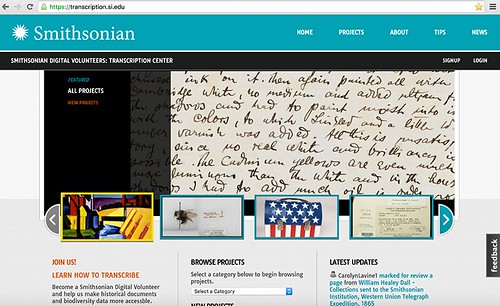
PREV ARTICLE
NEXT ARTICLE
FULL ISSUE
PREV FULL ISSUE
HOW THE SMITHSONIAN IS CROWDSOURCING HISTORY
Scanning a book or document and making the images available on the web is a great thing, but often more work is required to make
digitization completely usable. Here's how the Smithsonian Institution is drawing on the work of volunteers to help transcribe
digitized documents. -Editor

It’s the end of the day, you’ve worked hard, and now you’re home and it’s time to relax. So you open up your laptop and settle in to transcribe some bee specimen labels. Or the packing list of a space shuttle. Or the field notes of a naturalist tromping through early 19th century Ireland.
... or buyer's names in a 19th-century coin sale? -Editor
It may sound odd, but plenty of people would rather parse the curly, old-fashioned handwriting of a bugle player in a Civil War military band than stream an old episode of Breaking Bad, as part of the Smithsonian Institution’s online Transcription Center. So far, 5,883 volunteers from around the world have transcribed more than 150,000 pages from over 1,000 projects. This effort exists because of a simple fact: just digitizing something isn’t the last step in making something useful to scholars or the general population. “Digitizing materials is really important but that’s not the only step to making them accessible,” says anthropologist Meghan Ferriter, project coordinator of the Transcription Center. Launched in 2013, the project invites anyone with access to a computer to choose from a buffet of documents supplied by 14 of the Smithsonian’s libraries, archives and museums. Volunteers participate anonymously or create profiles, and each project comes with specific instructions. Participants read scanned pages and type their transcriptions into a field below. Many users work on multiple projects in small chunks, so that any given text is transcribed by a team. Transcriptions are reviewed by fellow volunteers and then signed off on by a Smithsonian staffer before being declared complete. To read the complete article, see:
Wayne Homren, Editor The Numismatic Bibliomania Society is a non-profit organization promoting numismatic literature. See our web site at coinbooks.org. To submit items for publication in The E-Sylum, write to the Editor at this address: whomren@gmail.com To subscribe go to: https://my.binhost.com/lists/listinfo/esylum All Rights Reserved. NBS Home Page Contact the NBS webmaster 
|